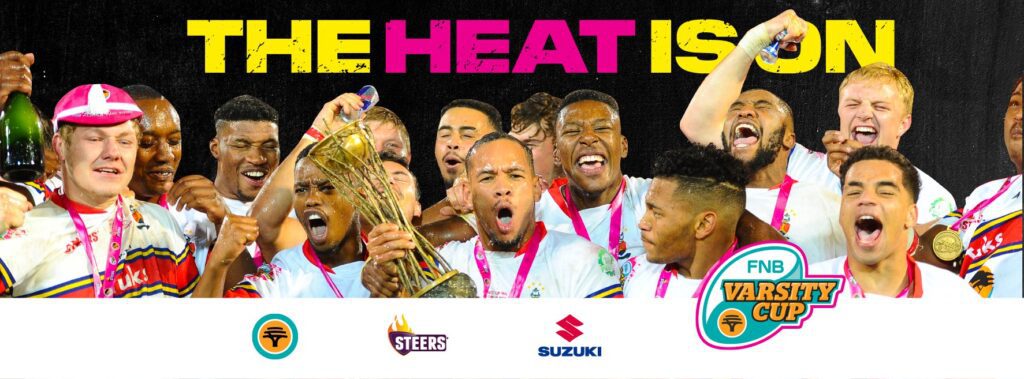The introduction of a shot clock, to increase ball in play time, is one of several new innovative laws which will be implemented in this year’s Varsity Cup.
The 2023 Varsity Cup campaign is set to get underway on 20 February, when UP Tuks host Shimlas in in Pretoria, followed by Maties against UCT in Stellenbosch, NWU Eagles playing UJ in Potchefstroom and CUT welcoming Wits to Bloemfontein.
ALSO READ: Ditched Israeli team hits out at SA Rugby
While the Varsity Cup abides by the rules and regulations of the sport as determined by SA Rugby and World Rugby, the prestigious competition continues to lead the way in terms of rugby law innovation to improve the game.
Here’s all you need to know about the unique Varsity Cup laws that will be used during the 2023 season:
SHOT CLOCK
• Conversion kicks must be taken within 60 seconds after a try has been scored, if the kick is not taken in 60 seconds, then the team forfeits the opportunity/points.
• Once the conversion is taken, time will be stopped and will only restart once the kick-off takes place.
• When a penalty try is awarded, time will stop when the try is awarded and restarted with the kick-off
With an average of 8 tries per match, this could potentially add an additional 2.5 minutes to bal- in-play time.
POINT OF ORIGIN TRY (POR):
In this season of the Varsity Cup, a team can gain additional bonus points upon scoring a try from their own half.
• Team gained possession inside their own half that scores a try without conceding possession of the ball: Try worth 7 points– (5pts plus 2 bonus points)
*The Varsity Shield tournament DOES NOT use the point of origin try rule and a try from anywhere on the field remains 5 points.
50/22 LAW VARIATION:
A team in possession in their half that kicks the ball indirectly into touch in their opponents 22 gets a free-kick 15m in from touch. That team may not take a scrum or lineout, they must take a tap kick. If that team scores from there, the try value will be 5 points. There is no requirement for a set phase inside your own half. A team may carry the ball back and kick it indirectly into touch inside the opposition’s half. If a team scores from the tap, the try value will be 5 points.
FREE-KICK LAW FOR CATCH FROM AIR:
Any catch from any kick from the air (except from a kick for the start or restart of the match) means a free-kick for the receiver right away. The receiver/defender doesn’t have to call anything.
The referee will play advantage, and have the ability to bring the play back to the point where the catch was made if the advantage has not been used and to award a free-kick to the receiver’s team.
The receiver however does have the right to call a free-kick like any other free-kick in the 22, and to use it as such. Thus, it is exactly the same as a free-kick in the 22 just extended to the rest of the field.
The mark law for the 22 stays the same. The free-kick is named a FREE CATCH.
DEFENDING SCRUMHALF:
Law: The “defending 9’s” offside line is limited to the tunnel where the shoulders of the opposing props meet.
Sanction: Penalty Kick
Aim: To create more time and space for the “attacking 9” to clear the ball at the base of a scrum.
Current Application: Currently the law allows the “defending 9” to follow but remain behind the ball as it is hooked in a scrum. He must also stay within 1m of the scrum. The “defending 9” may also retire to the hindmost foot of his teammate where he may then move further than 1m from the scrum. Lastly, he may retire to the backline, 5m away. He may not return to the offside line from which he has retired.
RED CARD RULE:
The Red Card Rule will work as follows:
If a red card is given to a player of a team:
• That team will play for 15 minutes with one less player, the player given the red card will go off the field.
• After 15 minutes another player may go back onto the pitch, but not the player who was awarded the red card.
The main intention of this rule change is to the contest stays alive amidst an early-game red card.
WHITE CARD:
The White Card will be used in the televised semi-finals and final of Varsity Cup only.
• The Team Coach or Captain can, during a stoppage in play, request the referee to review a decision they believe to be incorrect OR request him to review a possible infringement that went undetected and required an appropriate sanction.
SCRUMMING LAW:
The process for the scrum is the current sequence released by World Rugby for all competitions.
STRATEGY BREAKS:
One strategy break per half for three minutes, between the 18th and 22nd minutes of matches, will be allowed. The strategy break only occurs in the Varsity Cup, Varsity Shield and Young Guns competitions.
FIXTURE FORFEITURE:
In the event of a default or where a team has forfeited the fixture, the offending team loses 28-0 and the non-offending team will receive maximum log points (5).
ALSO READ: Sevens rugby race to Paris Olympics heats up

